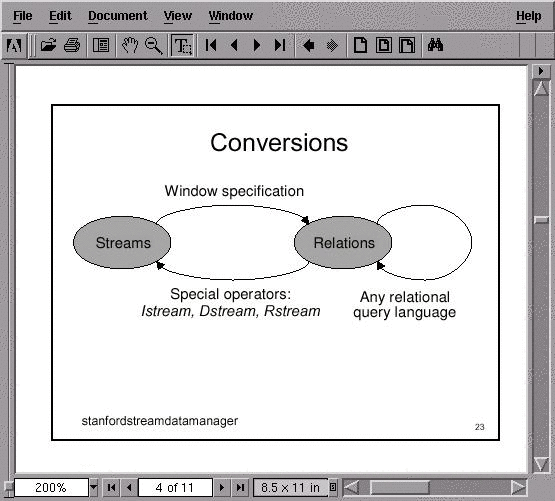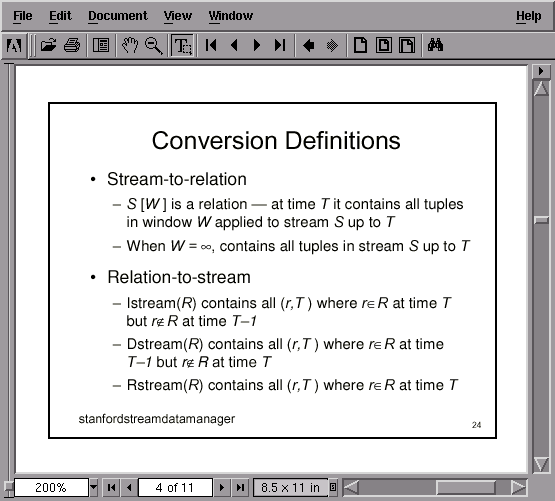The CQL Continuous Query Language
STREAM Online Help
>
Running the System
>
CQL Continuous Query Language
This section gives a quick introduction to the
CQL declarative continuous query language for streams and relations
supported by the
STREAM data stream management system. We also point to
literature where more information on CQL can be obtained.
We recommend that users of the demo read this page
before attempting to run queries on STREAM.
Introduction
CQL, which stands for Continuous Query Language,
is based on modifications to SQL to support streams plus relations
and continuous result semantics. CQL retains SQL's
familiar Select-From-Where syntax. Some new reserved
words have been added to support sliding windows, sampling, etc.
We will introduce the syntax and semantics of CQL through a few
examples.
Example CQL Queries
Here are a few example queries. These example queries are provided
in the Scripts menu of the stream client so that they can
be registered by simply running the corresponding script.
These queries are over streams R and S both
with a two-attribute schema consisting of a 20-byte
character attribute name and an integer attribute value.
These two streams have also been preregistered with the
system for the convenience of the user. The name of each
query corresponds to the name of the script for registering
the query in the Scripts menu of the stream client.
One Stream Query
This query is probably the simplest query that one can think
of over stream R.
SELECT *
FROM R
Simple Aggregation Query
This query is a simple windowed aggregation over stream S, the
window consisting of the tuples in the last 15 seconds in S.
SELECT name, AVG(value)
FROM S RANGE 15 SECONDS
GROUP BY name
Simple Join Query
This query is a simple windowed equijoin query over streams R and S on
attribute name, the windows each consisting of the last 10
tuples in the respective streams.
SELECT *
FROM R ROWS 10, S ROWS 10
WHERE R.name = S.name
These example queries show how CQL retains the look and feel of SQL by
retaining SQL's Select-From-Where-GroupBy syntax. CQL supports streams
in addition to relations. A stream in CQL is a possibly infinite
multiset of timestamped elements. Streams can appear only in the From
clause of a CQL query and they must be accompanied by a sliding window
specification, with the default window consisting of all tuples that
have arrived in the stream so far. (Since the example One Stream
Query does not specify a window over R, the default window will be
used.) Apart from the input streams that arrive at the system,
streams can also be derived from other streams and relations
using CQL (sub)queries.
A relation in CQL is like a materialized view in a traditional
DBMS: A relation is a time-varying multiset of tuples.
That is, a relation contains a (possibly empty) multiset
of tuples at any point in time and this multiset changes over time
though insertions and deletions of tuples.
A sliding window is applied to a stream and it converts the
stream into a relation. The three common types of sliding
windows used in CQL include:
-
Tuple-based windows: A tuple-based window is specified in the
form ROWS N, where N is a positive integer, and consists
of the last N tuples in the stream at any point of time.
The example Simple Join Query specifies tuple-based
windows of size 10 over streams R and S.
-
Time-based windows: A time-based window is specified in the
form RANGE N SECONDS, where N is a positive integer, and
consists of tuples in the stream that have timestamps that are within
the last N seconds. The example Simple Aggregation Query
specifies a time-based sliding window of 15 seconds on stream S. Other
specifications of time-based windows include: RANGE N MINUTES,
RANGE N HOURS, and RANGE N DAYS.
-
Now windows: Now windows are a special case of time-based
windows consisting of tuples in the current instant of time. Since the
lowest granularity of time supported by STREAM is 1 microsecond, the
current instant means the current microsecond in STREAM.
Now windows are commonly used in stream applications and are
specified using the NOW keyword. Examples
of Now windows are given in the
Running the Benchmark section of this help.
CQL Semantics
We now explain the semantics of a CQL query. The FROM clause of
a CQL query specifies a relation or the join of two or more
relations. Recall that if a stream appears in the FROM clause
of a CQL query, then the stream must be converted into a relation by
applying a sliding window, the default window consisting of all tuples
in the stream so far. The rest of the query, namely the SELECT,
WHERE, and GROUP BY clauses apply over the relational
output of the FROM clause, just like in a SQL query. The final
output of a SELECT-FROM-WHERE-GROUPBY CQL query is a
relation. Recall that a relation is just like a materialized view in a
DBMS. All three example queries above produce relational
results. Thus, if you run these queries in the system by streaming R
and S, you can observe that the continuous result produced by the
stream client contains the insertions and deletions to the output
relation, indicated by "+" and "-" respectively.
So far we saw how CQL queries convert streams to relations
and operate on relations. CQL
also supports the conversion of relations to streams. The complete
picture is shown below:

ISTREAM, DSTREAM, and RSTREAM are the three
operators supported by CQL to convert relations to
streams in queries. The semantics of these conversions are
defined below:

Intuitively, applying ISTREAM over a relation Rel (in
CQL, ISTREAM (SELECT * FROM Rel)) outputs a stream consisting of the
insertions to Rel. (Recall again that a relation in CQL is just
like a materialized view in a DBMS.) Similarly, applying
DSTREAM over a relation Rel (in CQL, DSTREAM (SELECT *
FROM Rel)) outputs a stream consisting of the deletions from
Rel. Applying RSTREAM over a relation Rel (in
CQL, RSTREAM (SELECT * FROM Rel)) will output a stream consisting of
the contents of Rel at each instant of time. We
give one example query here to illustrate these operators.
More examples follow in
the
Running the Benchmark section of this help.
Assume we have an relation CurPrice(stock integer, price float), where
price represents the current price of the stock
stock. We are interested in the average price of each
stock over the last day. This query can be expressed in
STREAM in the following manner:
REGISTER STREAM PriceStream (stock integer, price float);
ISTREAM (SELECT * FROM CurPrice) INTO PriceStream;
SELECT stock, AVG(price)
FROM PriceStream RANGE 1 DAY
GROUP BY stock
The above specification creates a derived stream called
PriceStream and specifies that this stream contains
the insertions to the CurPrice relation.
The CQL query then applies a 1-day window over
PriceStream and does the required aggregation.
More example CQL queries are given in
the
Running the Benchmark section of the help. Before
we give the citations to literature where more information
on the syntax, semantics, and execution of CQL queries
can be obtained, here is something that must be borne
in mind:
WARNING: The CQL syntax supported currently by STREAM differs
from the example CQL queries that have appeared
in previous papers and talks on CQL and also
from the queries in the
Stream Query Repository.
The authoritative source on
CQL query syntax supported currently by STREAM is available
here.
Noteworthy differences in CQL syntax
between the demo and earlier papers,
talks, and the stream query repository include:
-
Window specification.
-
CQL in STREAM currently does not support the sampling clause or
the window slide parameter. These will be added shortly.
-
CQL subqueries are not supported by STREAM. CQL queries
which need subqueries can be written using CQL Views supported
by STREAM. Please refer to examples of CQL Views given in
the
Running the Benchmark section of the help.
More Information on CQL
A complete treatment of CQL is beyond the scope of this document. For
more information, please refer to our paper
on CQL, Jennifer
Widom's presentation on CQL available here,
and the Stream Query
Repository. Please bear in mind the above warning on the
differences in CQL syntax between the demo and these papers,
talks, and the stream query repository.
Last modified: Mon Jan 8 00:34:05 PST 2003


